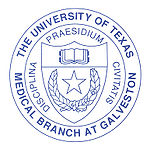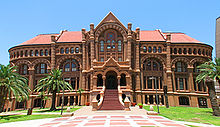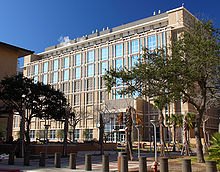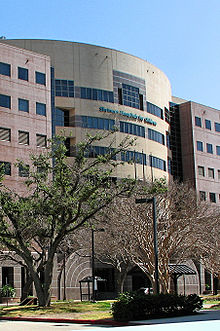|
(Redirected from University of Texas Medical Branch at Galveston)
"UTMB" redirects here. For other system schools, see University of Texas System.
|
|
This article may require cleanup to meet Wikipedia's quality standards. Please improve this article if you can. (September 2009) |
The University of Texas
Medical Branch |
 |
| 校训 |
拉丁语: Disciplina praesidium civitatis (Education, the Guardian of Society) |
| 建立于 |
1891 |
| 类型 |
Academic Health Center |
| 校长 |
David L. Callender, MD, MBA, FACS |
| 工作人员 |
12,000 |
| 本科生 |
2,255 |
| 研究生 |
900 |
| 位置 |
Galveston, Texas, USA |
| 校园 |
Urban, 350 acres (1.4 km²) |
| 颜色 |
Blue, white, and red |
| 网址 |
www.utmb.edu |
The University of Texas Medical Branch (UTMB) is a component of the University of Texas System located in Galveston, Texas, United States, about 50 miles (80 km) southeast of Downtown Houston. It is a health care complex spanning 85 acres (344,000 m²), with seven hospitals, 13,000 employees and an assortment of specialized clinics, centers and institutes, including a medical school. The medical school is the oldest one west of the Mississippi River.
It was established in 1891 with one building and fewer than 50 students. Today UTMB's campus has grown to more than 70 buildings and an enrollment of more than 2,500 students. The 84-acre (340,000 m) campus includes four schools, three institutes for advanced study, a major medical library, seven hospitals (including an affiliated Shriners Burns Hospital), a network of clinics that provide a full range of primary and specialized medical care, and numerous research facilities.
Since its founding, UTMB has served indigent or poor populaces, such as prisoners, the homeless, and single mothers, including patients with ailments that are very expensive to treat (such as burns). It is one of only a handful of hospitals in southeastern Texas that does so. Currently, UTMB is certified as a Level I Trauma Center and serves as a trauma facility for the nine-county region in southeast Texas, including the Greater Houston area.
The UTMB campus includes a Shriners Hospitals for Children and a prison hospital that serves 80% of the Texas prison inmate population [2]. In addition, because of its level of specialized care, UTMB serves many indigent patients from across the state. The university spends upwards of $500 million annually providing such care.
In 2003 UTMB received funding to construct a $150 million Galveston National Biocontainment Laboratory on its campus, one of only two in the United States and the only one on a university campus. It houses several Biosafety Level 4 research laboratories, where studies on highly infectious materials can be carried out safely.
It has schools of medicine, nursing, allied health professions, and a graduate school of biomedical sciences, as well as an institute for medical humanities.
UTMB also has a major contract with the Texas Department of Corrections to provide medical care to inmates at all TDC sites in the eastern portion of Texas. UTMB also has similar contracts with local governments needing inmate medical care.
UTMB is currently in the process of recovering from the effects of Hurricane Ike. Employees returned to work in early October, 2008.
历史

"Old Red", the medical school's original building.

The Galveston National Laboratory at UTMB is the first full-size BSL-4 lab located on a university campus in the United States.
The location of the Medical Department of the University of Texas was decided between Galveston and Houston in a popular vote in 1881, but its opening was delayed due to the construction of the main university campus in Austin, Texas. The need for medical training in Texas was great: in 1891, 80% of doctors in the state had under a year of formal training in medicine, and so the "Texas Medical College" was formed in Galveston with the idea that it would become the medical department once state funding began.
The original building, now called Old Red, was begun on 1890 under the supervision of the Galveston architect Nicholas J. Clayton. Clayton toured several medical colleges in the North and East before drawing up his plans for the building. The medical school campus also included the John Sealy Hospital, which provided charity care for any who claimed Galveston residence.
Upon opening, the Red Building had been starkly underfurnished, a problem which was not fully remedied until after the Hurricane of 1900, when the state rallied around the ravaged city. Dr. Thompson, professor of surgery, said that "the regents were so generous in repairing the damage to the building and restoring the equipment, that we were actually in better shape at the end of the year 1901 than we had been before." In addition, the damage to the roof of Old Red allowed for the addition of sky lights, which had always been wanted for the dissection room.
Ewing Hall is named for Maurice Ewing, a notable alum.
From its modest beginnings in the 1890s as the first state medical school in Texas, the University of Texas Medical Branch at Galveston (UTMB) has developed into a sophisticated health science complex for the state of Texas. UTMB is a large health sciences center, with the Graduate School of Biomedical Sciences, the School of Medicine, the School of Nursing,the School of Health Professions, the Institute for Human Infections and Immunity, the Institute for the Medical Humanities, an affiliated Shriners Burns Hospital, the Sealy Center for Molecular Medicine, the Sealy Center for Structural Biology, the Center for Biodefense and Emerging Infectious Diseases, the Center for Addiction Research, the Educational Cancer Center, the Center for Interdisciplinary Research in Women’s Health, the Insyitute for Translational Sciences [3], the Galveston National Laboratory (GNL), the Sealy Center for Cancer Cell Biology, the Sealy Center for Environmental Health and Medicine, the World Health Organization Collaborating Center for Tropical Diseases, the Stark Diabetes Center, the Center for Biomedical Engineering, the Center for Environmental Toxicology, the Sealy Center on Aging, the George P. and Cynthia Woods Mitchell Center for Neurodegenerative Diseases, and the Sealy Center for Vaccine Development. UTMB operates an extensive clinical care enterprise with a wide variety of specialty programs, all of which enhance the university’s commitment to education, research, and patient care.
UTMB occupies 85 acres at the eastern end of Galveston Island. The medical complex consists of 54 major buildings, including six on-site hospitals, the affiliated Shriners Burns Hospital, classroom buildings, specialty centers, extensive research laboratories (385,327 square feet), one of the nation’s largest and most comprehensive medical libraries, recreational facilities, dormitories, and administrative offices. The research facilities include the only full-sized biosafety level 4 laboratory associated with a medical school in the U.S., completed in 2003. The National Institute of Allergy and Infectious Diseases (NIAID) selected UTMB as the site of a $150 million national biocontainment lab, one of two large-scale national research facilities focusing on new and emerging disease threats, which opened in August 2008. More information about the Galveston National Laboratory at http://www.utmb.edu/gnl/default.htm
UTMB’s annual budget of approximately $1.4 billion includes grants, awards, and contracts from federal and private sources totaling more than $150 million, in addition to institutional allocations for research.
The presence of three World Health Organization collaborating centers on campus is an indication of the institution’s multidisciplinary commitment to research and education, addressing health needs throughout the world. For more information: http://www.utmb.edu. Virtual tour of UTMB: http://www.utmb.edu/tour/
In 1996, UTMB purchased the adjacent 128 year old St. Mary's Hospital, the first catholic hospital in Texas. The building was converted into the Rebecca Sealy Psychiatric Hospital.
The UTMB became a member of the Houston-based Texas Medical Center in 2010.
Schools
|
|
The neutrality of this section is disputed. Please see the discussion on the talk page. Please do not remove this message until the dispute is resolved. (August 2009) |
UTMB includes four schools:
- School of Medicine - The School of Medicine [4] at UTMB has provided medical school or residency training to one in six Texas physicians. With 20 departments, three institutes and a unique partnership with the University of Texas at Austin and Seton Healthcare in Austin, UTMB’s School of Medicine is a leader in medical school education, translational research and clinical care. The University of Texas Medical Branch (UTMB) is a major academic health center dedicated to improving the lives of others through health sciences education, clinical care and biomedical research. Opened in 1891, UTMB combines a rich history of service with a forward-thinking spirit to fulfill its role as a public trust for the people of Texas and beyond.
- Graduate School of Biomedical Sciences - The Graduate School of Biomedical Sciences (GSBS) is one of four degree-granting schools at UTMB and plays a major role in research and scholarship at the university [5]. Biomedical graduate programs were started in 1952, and a separate graduate school was established in 1969, becoming the Graduate School of Biomedical Sciences in 1972. There are 323 faculty members in the graduate school. UTMB maintains an excellent faculty-to-student ratio, with 341 graduate students enrolled, therefore you would work more closely with these excellent faculty. Every year approximately 50 graduate students enroll, and as of August 2006, there are 1,255 GSBS alumni who have gone on to diverse successful careers.
The graduate school has 11 degree-granting programs: Biochemistry and Molecular Biology [6], Cell Biology [7], Cellular Physiology and Molecular Biophysics, Experimental Pathology [8], Master of Medical Sciences [9], Medical Humanities [10], Microbiology and Immunology [11], Neurosciences [12], Nursing [13], Pharmacology and Toxicology [14], and Preventive Medicine and Community Health [15]. These programs provide curricula that prepare you to be successful in today’s fast-moving biomedical research environment. Most of the programs and their facilities are closely allied with their medical school departments and also interact in interdisciplinary and clinical pursuits. An M.D./Ph.D. Combined Degree Program [16] is offered in conjunction with the UTMB School of Medicine.
The Graduate School of Biomedical Sciences provides an excellent basic science background for its students. Its faculty members produce outstanding nationally and internationally recognized research and are dedicated to the search for new biomedical knowledge and the training of future biomedical scientists.
The GSBS and the UT Telecampus [17] have created a concurrent enrollment program by which graduate students at UTMB can pursue both a Ph.D. and an M.B.A. in preparation for careers in biotechnology and the pharmaceutical industry, among other career opportunities.
For more information: http://www.gsbs.utmb.edu/
Sources of Financial Support
Every effort is made to provide financial support for GSBS students. Students may qualify for predoctoral fellowships from the graduate school with an initial stipend of at least $25,000 (2008–2009), and paid health insurance for those pursuing a Ph.D. degree. These stipends are awarded according to merit and the recommendation of the program faculty. Tuition and fees for first-year BBSC students will be paid by the GSBS and the mentor will fund tuition fees in years thereafter. Financial support may be available from other sources for students engaged in research or teaching projects. James W. McLaughlin Fellowships are awarded primarily to advanced students concentrating in the areas of infection and immunity and include additional benefits for dependents, travel, and research supplies. Research grant support is normally available only to students who have decided on laboratories in which they wish to work and have chosen research projects. A number of NIH-funded training grants also provide stipend support to Ph.D. students on a competitive basis. GSBS Alumni and Their Success
Completing your graduate degree at the UTMB Graduate School of Biomedical Sciences provides you with the opportunity to pursue a variety of careers. UTMB alumni fill positions in academia, biotech companies, large and small pharmaceutical firms, law firms, publishing companies, contract research organizations, state and federal government agencies, and other universities across the United States and the world. They work as scientific writers, patent lawyers, bench scientists, teachers, administrators, and military doctors. In an analysis of GSBS graduates within the last 10 years: 51 percent are in academic areas or positions, 11 percent work in government agencies, 8 percent are in business environments, and 12 percent are in other types of health care institutions. A graduate degree from UTMB opens a gateway to many futures. Use your imagination and take advantage of the numerous opportunities that are available for those with Ph.D. degrees in the biomedical sciences. UTMB graduates can be found living and working in almost every state and numerous foreign countries.
- School of Nursing - Welcome to the University of Texas Medical Branch School of Nursing, the first School of Nursing in Texas [18]. Located on historic Galveston Island in the Gulf of Mexico, we enjoy moderate climate year round, making it a great place to pursue nursing education endeavors
- School of Health Professions - The most experienced allied health sciences school [19] in the Southwest! For over a century, the University of Texas Medical Branch has dedicated its efforts toward improving the health of Texans. Since 1968, we in the School of Health Professions have helped carry on this tradition. Over 6,000 professionals for the nation's healthcare workforce have gotten their education with us - the vast majority of whom continue to practice in Texas. For more information about getting your education at UTMB, please contact the SHP Office of Admissions and Student Affairs by phone at (409) 772-3030 or by email at recruitment.sahs@utmb.edu.
Hurricane Ike
Hurricane Ike caused significant flood damage to nearly every building on campus, including the John Sealy Hospital. However, UTMB has about $1.4 billion to restore, harden and expand its campus. Much of the money was approved by the 81st Texas Legislative session, $450 million comes from FEMA, $130 million from insurance, $200 million from the Sealy and Smith Foundation, and $50 million from the Social Service Block Grant Funds.
Hospitals and clinics

The Shriners Hospital for Children on UTMB's campus.
- John Sealy Hospital - a 12 story, 414 bed general care teaching hospital.
- Jennie Sealy Hospital - hospital serving geriatric patients as well as the Sealy Center on Aging.
- University Hospital Clinics Building - a seven story specialty clinics building
- UTMB Pediatrics and Childrens Hospital - a six story children's hospital with 50 inpatient beds, 12 PICU beds, 30 newborn and 42 high acuity beds.
- R. Waverly Smith Pavilion - houses the university's gynecological, obstetrical and newborn nursery services, including the university's neonatal intensive care unit.
- Rebecca Sealy Hospital - houses UTMB's day surgery services, the Regional Psychiatric Hospital for Mental Health–Mental Retardation patients, and inpatient hospitalization programs for the Department of Psychiatry and Behavioral Sciences.
- Shriners Burns Hospital for Children - A 30 bed children's hospital specializing care and treatment of acute burns, patients needing plastic reconstructive or restorative surgery as a result of "healed" burns, and scarring and deformity of the face. It has an Intensive Care Unit with 15 acute beds, a reconstruction and plastic surgery unit with 15 reconstruction beds, three operating rooms, a multi-bed recovery room, and numerous clinics. Its a Verified Burn Center by the American Burn Association.
- UTMB Criminal Justice Hospital - operated in collaboration with the Texas Department of Criminal Justice, the prison hospital has 172 inpatient beds, a multi-service ambulatory care center, a minor operating room with a recovery room, a telemetry unit of 12 beds, a medical intensive care unit of six beds and a 56-bed overnight holding unit.
Size and budget
- Enrollment: 2,422 (Fall 2007)
- Faculty: 1,268 (Fall 2007)
- Personnel: 11,323 (Fall 2007)
- Budget: $1.452 billion (FY 2008)
- Research Expenditures: $156.1 million (FY 2007)
知名校友与教职
- Robin Armstrong, M.D. - Internal medicine, physician in Galveston County, and vice chairman of the Republican Party of Texas
- Maurice Ewing - Geophysicist
- Hector P. Garcia - Surgeon, civil rights advocate
- Bernard A. Harris, Jr. M.D. - Astronaut
- Patricia Robertson M.D. - Astronaut-candidate
- Luther Leonidas Terry - Surgeon General
- William E. Thornton M.D. - Astronaut
- Satya Prakash Ph.D - DNA Repair
- C.J. Peters M.D. - Virology & Immunology
- David Walker M.D. - Bacteriology
[edit] Heliports
 |
Wikimedia Commons has media related to: University of Texas Medical Branch |
UTMB has two heliports: the Ewing Hall Heliport (FAA LID: 9TS7) and the Emergency Room Heliport (FAA LID: 9TA7).
- University of Texas Medical Branch Emergency Room Heliport
- Airport information for 9TA7 at AirNav
- Aeronautical chart for 9TA7 at SkyVector
- University of Texas Medical Branch Ewing Hall Heliport
- Airport information for 9TS7 at AirNav
- Aeronautical chart for 9TS7 at SkyVector
参考文献
Footnotes
- ^ [1]
- ^ "UTMB News & Information". http://www.utmb.edu/. Retrieved 2008-09-22.
- ^ See also "Discovering Dengue Drugs Together project slowed down because of hurricane". http://www.worldcommunitygrid.org/forums/wcg/viewthread?thread=21894#185264.
- ^ "UTMB's Hurricane Ike Emergency Information and Resource Site". http://www.utmb.edu/ike/. Retrieved 2008-10-07.
- ^ "St. Mary's Hospital will close/UT branch to buy 128-year-old unit". Houston Chronicle. http://www.chron.com/CDA/archives/archive.mpl?id=1995_1314679. Retrieved 2009-10-03.
- ^ Wollam, Allison. "UTMB becomes TMC member institution." Houston Business Journal. Tuesday March 2, 2010. Retrieved on March 12, 2010.
- ^ Kappes, Hayley. "UTMB partners with Texas Medical Center". Galveston Daily News. http://www.galvnews.com/story.lasso?ewcd=d4a70cfc31550865. Retrieved 05/13/2010.
- ^ "UTMB Joins Texas Medical Center: UTMB Is About 50 Miles Away From Texas Medical Center". KPRC Click2Houston. http://www.click2houston.com/health/22726562/detail.html. Retrieved 05/13/2010.
- ^ http://www.utmb.edu/iutmb/more/Legislature_06-01-09.asp
- ^ UTMB MFM Fellowship
- ^ UTMB Pediatrics & Childrens Hospital: About the Hospital
- ^ UTMB Campus Tour: Rebecca Sealy Hospital
- ^ Galveston Shriner's Hospital
- ^ UTMB TDCJ Hospital Overview
- ^ UT System Fast Facts
Bibliography
- University of Texas Medical Branch at Galveston (1967). The University of Texas Medical Branch at Galveston: A Seventy-five Year History by the Faculty and Staff. Austin, Texas: University of Texas Press. LCCN 67028060.
External links
 |
Houston portal |
 |
Health portal |
- University of Texas Medical Branch
|
|



